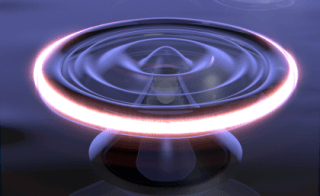Apr 5 2016
Australian researchers from The University of Queensland have, for the first time, used laser light to cool a special form of quantum liquid, called a superfluid.
 A bright laser beam was used to draw energy out of waves on the surface of the superfluid. Credit: Dr Christopher Baker and Professor Warwick Bowen
A bright laser beam was used to draw energy out of waves on the surface of the superfluid. Credit: Dr Christopher Baker and Professor Warwick Bowen
Lasers are widely used to cool gases and solid objects, but have never before been applied to cool a quantum liquid.
The findings were released today in the journal Nature Physics.
Superfluids are quantum liquids with a strange property - much like electrical currents in superconductors, the flow of a superfluid never stops.
Lead author Dr Glen Harris, who is now building on these experiments with a team at Yale University, said this unique property was a key feature for many of the proposed applications of superfluids.
“The applications of this research range from improved sensors for navigational systems to the development of quantum devices and fundamental exploration of the quantum physics of turbulence, or the turbulent motion of quantum fluids when cooled to temperatures close to absolute zero,” Dr Harris said.
In the experiments, the team created a superfluid helium film on a silicon chip.
They then used a bright laser beam to draw energy out of waves on the surface of the superfluid, cooling them.
In addition to laser cooling, the research team showed that combining superfluid with microphotonics allows extremely precise measurements of superfluid waves.
The project’s chief investigator Professor Warwick Bowen said that this research provides a pathway towards replacing state-of-the-art inertial systems used in navigation systems.
“Previous experiments have shown that ultra-precise inertial sensing is possible using superfluid helium. However, these experiments relied upon bulky architectures somewhat akin to a plumbing system for water,” Professor Bowen said.
"The ability to cool, measure, and control superfluid waves on a silicon chip brings a new level of scalability and integrability to such sensors," Professor Bowen said.
The experiments were performed by an international team of researchers from Australia, New Zealand, France, Belarus and Ireland. They would not have been possible without micro- and nanofabrication infrastructure within Australian National Fabrication Facility (ANFF) supported by the National Collaborative Research Infrastructure Strategy (NCRIS).
The project was funded by the ARC Centre of Excellence for Engineered Quantum Systems.